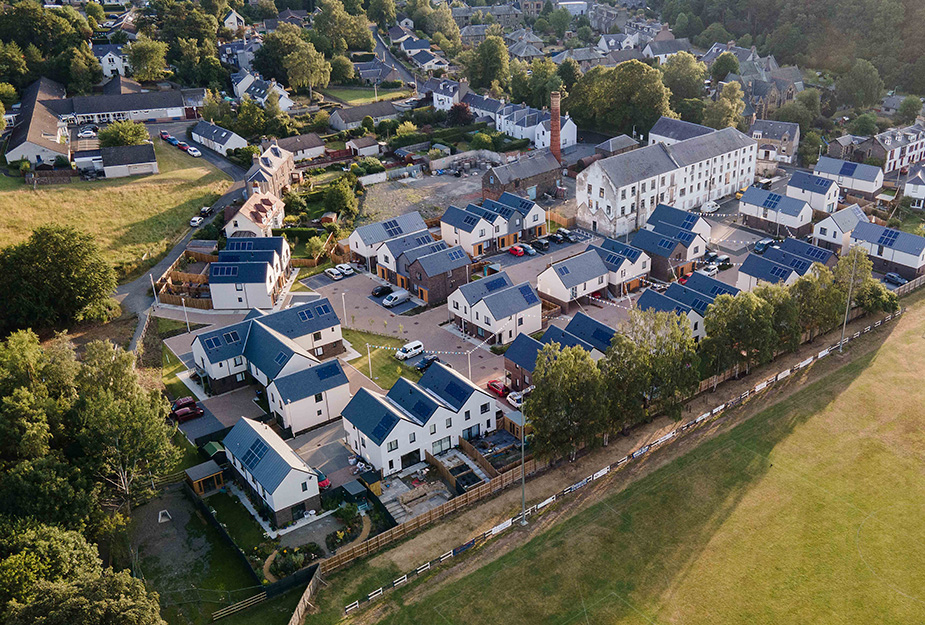Unlocking Town Centre Living: insights from private sector engagement

(January 2025) A study led by Architecture and Design Scotland Principal Architect and Urban Designer Johnny Cadell and Associate Director of Scottish Futures Trust Mhairi Donaghy, engaged with private sector housing developers in 2024 to discuss the merits of Town Centre Living, opportunities for growth and barriers to successful delivery.
A targeted study tested opportunities and barriers to growth in the delivery of Town Centre Living development by private sector housing developers in Scotland. The study was carried out in autumn 2024 on behalf of Scotland’s Town Centre Action Plan (TCAP) Forum, to fill a gap in representation following practitioner consultation during a series of Town Centre Living Roadshows in spring 2024.
During the Roadshows the private sector were found to be relevant but limited actors within the delivery of town centre regeneration. This study forms part of the research and review tasks undertaken by the Town Centre Living working group over the past two years. The study findings will inform the ongoing work of the Town Centre Living working group comprising Scottish Futures Trust, Architecture and Design Scotland, Scotland’s Towns Partnership and Scottish Land Commission.
Data collection and analysis
We conducted a series of interviews with Scottish Futures Trust and with support from Homes for Scotland. This engaged leading representatives of development companies with recent delivery experience of newbuild or retrofit housing across Scotland’s town centres from Kirkwall to St Andrews, Clydebank and Innerleithen. Eight semi-structured interviews were conducted in person using a standard questionnaire, with common themes from transcripts identified using AI software. Outputs were analysed and verified by both interviewers.
The summary findings, as presented below, provide evidence of perceptions regarding the state of health of Town Centre Living development from an investor and private sector perspective, representing a snapshot of opinion from a key sector responsible for delivery in the context of national policy aims.
Summary of opportunities and barriers to growth for Town Centre Living
Findings are reported under the five overarching themes that the Town Centre Living working group identified following the 2024 roadshows - a summary video of the roadshow output can be found here.
Leadership and collaboration
Nationally aligned policy frameworks across local authorities would increase confidence: a consistent, pragmatic approach across (and within) local authorities is crucial for addressing Town Centre Living-specific challenges like parking, heritage conservation, and infrastructure constraints.
Public investments in local infrastructure, public realm enhancements and streamlined planning processes all help to build confidence and attract private sector participation.
New investments in decarbonised housing and retrofit of existing structures could offer openings for scalable Town Centre Living initiatives.
Holistic planning and placemaking
Multiple knock-on benefits of revitalising housing in town centres were indicated - economic, social, health, wellbeing and environmental, including:
- Town Centre Living projects can transform underutilised or disused areas into vibrant, sustainable communities. Increased population density in town centres boosts economic activity, supports local businesses, and generates council tax revenues, as well as passive policing that creates a better sense of safety and security for residents and visitors.
- Town Centre Living fosters a sense of community, improves access to amenities, and promotes active travel, contributing to residents' health and wellbeing.
- Repurposing existing structures and promoting walkable neighbourhoods reduces carbon footprints and supports active travel, aligning with progress to net zero goals.
The importance of a holistic housing brief was indicated, including:
- Integrating social, affordable, and private housing to create sustainable, inclusive communities.
- Access to local health, education and transport services, especially for large Town Centre Living projects.
Value of design – skilled and tailored design was noted as playing a key role in successful projects, especially in complex town centre settings, to address:
- integration and sensitivity to local character and context
- managing complex functionality such as mix of use, adjoining uses
- the design of community-focused public spaces
- site and infrastructure constraints
Successful town centre living projects act as a catalyst for urban regeneration and further investment, drawing in complementary developments and enhancing urban vitality.
Funding and resources
Smaller development companies (SMEs) struggle to secure financing for Town Centre Living projects, especially during the early stages or for pre-planning work when finance is at risk.
Working in constrained urban environments increases costs and deters contractors. Some developers noted that in town centre sites they have struggled to recruit contractors due to the difficulty of parking works vans and receiving deliveries of materials.
Creative funding models are required in this context to address the challenges; such as joint ventures, partnerships, guarantees and shared-risk contracts.
The removal, or reduction, of development levies and tax burdens for Town Centre Living projects would be an incentive. This has the potential to support the repurposing of existing vacant/ underused spaces.
Investors can be attracted, marketability and values enhanced, by mixed-use areas and community-focused spaces.
Local engagement and partnership
Despite their decline, SMEs are recognised as key players in Town Centre Living due to their agility and innovative practices, but they need adequate support, such as smoothing the consenting journey and partnership working with Councils and other local stakeholders.
Collaboration and flexibility by local authorities are required: developers value early engagement with local authorities to align on project visions and address regulatory complexities.
Developers have successfully used a range of tools to engage with local communities before, during and after projects. Relationships with communities are seen as an important part of the development process.
Risk mitigation
Complex and disjointed planning and approvals processes were regarded as significant barriers to investment. Developers face hurdles such as lengthy approval times, conflicting regulations, and inflexible policies. Some developers noted that as a result of this disjoint, they have held assets (land and properties) for up to 18 months after acquisition before the start of any construction works. Masterplan consent areas are seen as a positive opportunity to reduce/ remove consenting risks.
Misalignment between housing demand (e.g. providing for downsizers in town centres) and mismatched policy requirements unsuited to the town centre context (e.g. high levels of parking provision required) affects project viability. In some authorities, zero% parking has been successful.
Well-serviced and prepared development sites or buildings are more attractive to developers as they reduce risk and save time.
The future of Town Centre Living: concluding thoughts
This study supports and develops the findings that emerged from the Town Centre Living roadshows, indicating endorsement from private sector actors of the economic, social and environmental benefits of Town Centre Living development. However, existing qualities and pull factors must be in place to attract private sector investment and the presence of these factors is typically limited to high value locations such as St Andrews or Scotland’s city centres.
Actions by some local authorities have been effective enablers for private sector investment in town centres, including investments in the public realm and transport infrastructure, alongside planning policy and design focussed on creating attractive conditions. Nevertheless, constraints for bank funding, gaining consents, risks to viability and taxation are all manifest barriers to Town Centre Living development with only the most agile, resilient and innovative able to operate in this environment.
Many SME development companies have gone into receivership in recent market conditions. To foster the sector and for Town Centre Living development to become more prevalent, increased partnership working and risk sharing is required between the public and private sectors, with a need for the public sector to align policies and practices to aid consenting processes.
(Header image credit: Housing at Caerlee Mill, Innerleithen, by Whiteburn Projects)
Town Centre Living partners
The project was initiated and will be followed up by the Town Centre Living working group partners.




